Carboxylic Acids Nomenclature MDCAT Quiz with Answers

Carboxylic Acids Nomenclature MDCAT Quiz is an essential part of organic chemistry for MDCAT students. The understanding of the naming of carboxylic acids, based on their structure and according to IUPAC (International Union of Pure and Applied Chemistry) rules, is very necessary for the identification of these compounds in the exam. Carboxylic acids are named based on the length of the carbon chain and the presence of the carboxyl group (-COOH) as the primary functional group.
Basic Naming Rules: Parent Chain Selection: The longest chain that contains the carboxyl group (-COOH) is selected as the parent chain. The carbon of the carboxyl group is always numbered as C1, and the rest of the chain is numbered accordingly.
Suffix: The suffix-oic acid is added to the root name of the parent hydrocarbon chain. For example, ethane (C₂H₆) becomes ethanoic acid (acetic acid, CH₃COOH), and butane (C₄H₁₀) becomes butanoic acid.
Carboxyl Group Location: Because the carboxyl group is always at the end of the chain, it is usually not necessary to use the position number because the carboxyl group is understood to be at the first position.
Substituents and Complex Names: Substituents: If substituents (such as methyl, ethyl, or halogens) are present, their location is indicated by a number. These go before the name of the parent acid, and in alphabetical order. Thus, 2-chloroethanoic acid means that chloroacetic acid has its chlorine on the second carbon.
Aromatic Carboxylic Acids: When a carboxylic acid is derived from benzene, the carboxyl group is attached directly to the benzene ring. The acid is named based on its position relative to the carboxyl group. For instance, benzoic acid (C₆H₅COOH) is a simple aromatic carboxylic acid. If other substituents are present, numbers are used to specify their position (for example, 3-nitrobenzoic acid).
Naming Dicarboxylic Acids: Dicarboxylic acids have two carboxyl groups. The parent chain is numbered to give the two carboxyl groups the lowest possible numbers. Thus, ethanedioic acid, commonly called oxalic acid, is the simplest dicarboxylic acid, with two carboxyl groups on a two-carbon chain. Butanedioic acid, commonly named succinic acid, has two carboxyl groups attached to a four-carbon chain.
If other functional groups are present, the carboxyl group takes precedence in the name, and other functional groups are named as substituents. Thus, 2-hydroxybenzoic acid, commonly named salicylic acid, has both a hydroxyl group (-OH) and a carboxyl group (-COOH) attached to a benzene ring.
Cyclic Carboxylic Acids: If the carboxylic acid has a ring, it is named with an appropriate prefix or series of prefixes indicating the number of carbons in the ring plus-carboxylic acid. Cyclohexanecarboxylic acid, thus, means a carboxylic acid attached to a cyclohexane ring.
Many carboxylic acids have common names that are different from their IUPAC names. For example, ethanoic acid is more commonly known as acetic acid, and methanoic acid is better known as formic acid.
Quiz: Test Your Knowledge of Carboxylic Acids Nomenclature
Try our MDCAT Quiz on carboxylic acids nomenclature to test your knowledge in naming carboxylic acids based on their structure, substituents, and functional groups. The quiz will ensure you’re prepared to correctly identify carboxylic acids in the MDCAT exam.
Free Flashcard: Key Insights on Carboxylic Acids Nomenclature
Our Free Flashcard set on carboxylic acids nomenclature offers a quick and effective way to revise the naming rules, including handling dicarboxylic acids and aromatic carboxylic acids. These flashcards are perfect for reinforcing your knowledge and ensuring you’re ready for the MDCAT exam.
Experience the real exam environment with our expertly designed collection of over 25,000 MCQs MDCAT Mock Tests.






